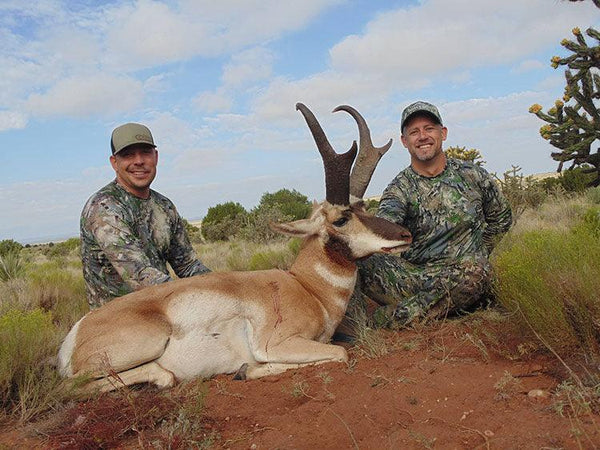Field Judging Pronghorn Antelope
Aug 30, 2021
The pronghorn antelope is one of the most unique big game animals in North America. Knowing how to field judge a trophy pronghorn antelope can be one of the most challenging aspects of hunting antelope.
When it comes to field judging there are many fine points to understand if you are looking to find one that makes the 80 inch minimum for inclusion into the Boone & Crockett awards book. The task of field judging is further complicated by the seemingly endless shapes and formations of their horn growths. The most common shape of a pronghorn is horn growth that goes straight up from the head but at a 45 degree angle or less if viewed from the front or rear.
Since pronghorn are usually found in open country the use of a high power spotting scope and good binoculars are a must to pick up on the details that will add up to inches of difference.
In this article I am going to focus on judging for score using the 3 components used for measuring, MASS, PRONG, and LENGTH. Spread means nothing when it comes to scoring a pronghorn but it does play a factor when properly judging size. Wide flaring horns appear shorter from the sides than they really are, horns that grow straight up out of the head will appear longer than they really are.
The second factor that affects horn size perception is the hook or curl at the top of the horns. A big curl that almost points back down is going to be longer than it appears while horns that go up without much curl or hook will actually be shorter than they appear.
The final factor that makes perhaps the largest difference in judging score accurately is the difference between ROUND MASS or FLAT MASS. Round mass is exactly that, round and appears heavy from all angles. Flat mass is common and it is where the horn appears massive from the side BUT thin when viewed from the front or the back.
Elite Hunters Use Only The Best Gear
SKRE Gear® Elite Essentials Bundle provides the essentials for Early to Mid-Season Hunting. Perfect for cool mornings and warm afternoons.
Shop Elite Essentials Bundle
MASS OF HORNS
Since there are 8 total mass measurements on a pronghorn it is easy to see how this is the single most important feature when judging trophy pronghorn. Heavy horns are a must to build a score up but how do you know you are looking at heavy horns? The eyeball is the most important reference when it comes to mass. On the average pronghorn the eye will measure about 2-1/4 inches from the front corner to the back. Using this reference you want to have horn bases at least 1.5 times as wide as the eye and that will put you in the 6”-7” base circumference. The first quarter circumference many times is the same as the base if not larger. As far as the last 2 circumferences above the prong you want the horn above the prong to be at least 2/3 as wide as the eyeball when viewed from the side and the taper to the tip to be gradual and retain most of that mass from above the prong.
PRONGS
The prongs of a record class buck will appear very large and pronounced. The eyeball is once again used as a reference that will help you determine the length of the prong. You want to figure out this length in 2 parts, The distance from the back of the horn to the front of the horn, then the length of the prong off the front of the horn. The distance off the horn you want at least 1.5 times the width of the eye. You want prongs that will measure at least 5-1/2 inches and preferably 6 inches or more. Keep in mind a very heavy horn will give you more credit for total prong length than a less massive horn will.
HORN LENGTH
Length many times gets too much focus by new pronghorn hunters and understandably so. A really tall pronghorn will catch your attention but if he has flat mass and small prongs his score will be much less than you expect. I’ve seen 17” pronghorn that score in the low 70’s and also have guided family members to pronghorn UNDER 14” that score in the 80’s. The most important facial feature to use in determining horn length is the ear. Most pronghorn have ears that measure 6 to 6-1/2 inches. If the horns appear to be 2-1/2 times the length of the ear then you have a good candidate. Generally speaking 15 inches and above is the length you are looking for on a trophy pronghorn.HOW TO ADD IT UP
After two decades of pursuing trophy pronghorn bucks the process I use to determine trophy quality is what I call the 20/20 rule. An 80” pronghorn is large enough to make the awards book for Boone & Crockett and considered an exceptional buck by most and is an easy example of my 20/20 rule.
Length + Prong = 20” (The sum of horn length and prong length equal 20”)
Mass = 20” (The sum of all 4 mass measurements equal 20”)
Now this is obviously done on one horn and you are trying to reach a total of 40” when that is added to the other horn (pronghorn are usually VERY symmetrical) you have an 80” buck. To account for the different variations of horn mass, prongs, and length you simply adjust from the 20/20 benchmark. Heavy horns may make your mass total 22” and in that case your length + prong only has to be 18”. On the opposite side of the spectrum a 17” tall buck with 6” prongs can be relatively thin and still make the 80” mark as the mass measurement only need to total 17 inches per horn. As with any field judging the best way to become proficient is to practice these rules on mounts at your local sporting goods store or your buddy’s trophy room and also get as much time watching live bucks as possible. Good luck this fall and remember JUDGE TWICE, SHOOT ONCE!
If you want to set yourself up for a successful pronghorn hunt, make sure to purchase SKRE's Elite Essentials Bundle!
Written by Erick Stanosheck




